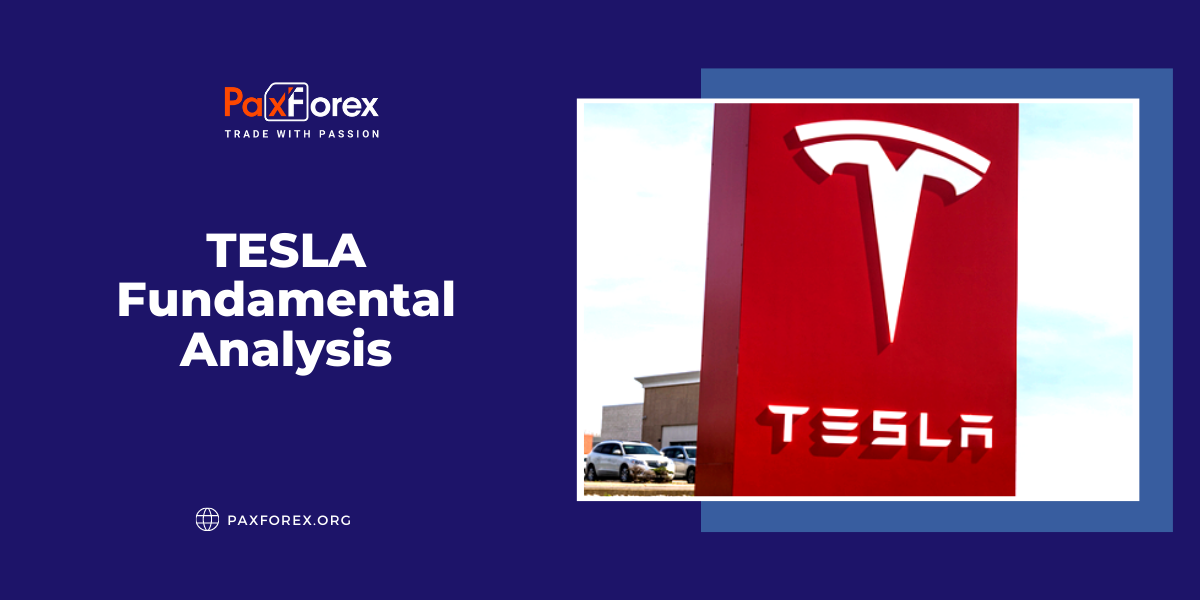
Source: PaxForex Premium Analytics Portal, Fundamental Insight
Since Tesla CEO Elon Musk revealed his stake in Twitter on April 4, TSLA stock has started to fall steadily, dropping 42%. As the ongoing saga between Musk and Twitter grows more complicated, some investors may wonder if Musk has been distracted by one of his most successful companies.
Even despite stock-related distractions, Tesla as a company has become an absolute force. The company reported a solid Q1 and set ambitious long-term goals, inspiring investors. But the question that has haunted Tesla for years is still being asked: Is Tesla's valuation too expensive for what the company is doing?
As for car production, Tesla's recent reports have been full of good news. In Q1, production was up 69% year over year, leading to an 87% YoY increase in car sales revenue. Because revenues grew faster than production, Tesla is generating better margins per vehicle produced. These margin increases are due in part to the price increases introduced in 2021 and to production efficiencies in the Model S and X, which are more expensive cars.
This increase in revenue was certainly reflected in the bottom line, as quarterly net income rose 658% YoY. Tesla's 17.7% net profit margin was even more impressive, making it one of the best in the auto industry.
Tesla is approaching luxury car margins. As such, it should be valued closer to Ferrari with 35 times earnings than General Motors with 6 times earnings or Toyota with a price-to-earnings (P/E) ratio of 8.6. Although Tesla is still valued at 90 times earnings, it could reach that threshold if it maintains its growth.
Management also gave investors great news: it expects car deliveries to grow 50% annually over the next few years. Using this forecast to model revenue growth and keep Tesla's profit margin at 17.7%, Tesla could generate $14.9 billion in profits by the end of 2022. That means Tesla is trading at a 49.5 to earnings ratio for all of 2022, which is not a bad estimate for a company that expects annual growth of about 50% over the next few years.
Given the recent stock sell-off, we don't have to worry about Tesla's valuation as we would have when the company's stock was trading above $1,000 a share. Strong growth and a reasonable valuation make Tesla stock an intriguing investment, but the business model should also be solid to invest in.
How does Tesla have such high-profit margins compared to traditional automakers? First, it got rid of middlemen. Because Tesla sells cars directly to consumers, it does not have to share profits with dealers. Many people don't like this business model, but it brings Tesla significant benefits.
It also focuses exclusively on electric vehicles (EVs). Regardless of your attitude toward electric cars, it's clear that the auto industry is moving in that direction. While traditional automakers are still a couple of years away from full EV production, Tesla is going full steam ahead. It's gaining an edge first and attracting lots of customers, while other manufacturers are still prototyping or just starting to ramp up production. Moreover, all four Tesla production models (3, S, Y, and X) are among the ten most satisfactory cars according to Consumer Reports, ranking first, third, fourth, and tenth, respectively.
As the average price of gasoline in the U.S. reaches an all-time high, more and more consumers are seriously considering switching to EVs as their next vehicle. If Tesla can keep up with demand, it will be able to attract customers before traditional automakers do, giving Tesla a big advantage.
However, the cost of raw materials such as nickel and cobalt used in the production of batters has reached record levels, which will increase the cost of producing Tesla vehicles. The range is one of the main problems many consumers face when switching to electric cars. However, if car buyers can settle for models with a standard range, Tesla's lithium-iron-phosphate (LFP) batteries can provide excellent performance without increasing the price.
As long as the price is below the 736.00 level, follow the recommendations below:
- Time frame: D1
- Recommendation: short position
- Entry point: 673.85
- Take Profit 1: 628.00
- Take Profit 2: 575.00
Alternative scenario:
If the level of 736.00 is broken-out, follow the recommendations below:
- Time frame: D1
- Recommendation: long position
- Entry point: 736.00
- Take Profit 1: 822.59
- Take Profit 2: 906.28













